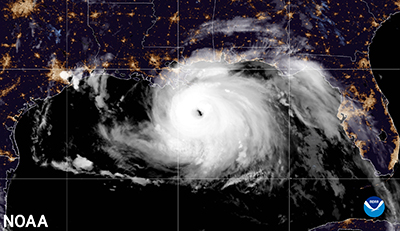
NOAA Sees Above-Normal Hurricane Season

Hurricane Ida makes landfall in 2021. Satellite image courtesy NOAA.
Okay, all you holders of residential and commercial real estate along the Atlantic coast and the Gulf of Mexico: brace yourself for another potential summer of sandbags and insurance claims.
The National Oceanic and Atmospheric Administration said an ongoing “La Niña” and above-average Atlantic Ocean temperatures are setting the stage for another busy tropical storm/hurricane season. Forecasters at NOAA’s Climate Prediction Center, a division of the National Weather Service, are predicting above-average hurricane activity this year — which would make it the seventh consecutive above-average hurricane season.
The NOAA outlook for the 2022 Atlantic hurricane season, which extends from June 1 to November 30, predicts a 65% chance of an above-normal season; a 25% chance of a near-normal season; and a 10% chance of a below-normal season.
For the 2022 hurricane season, NOAA forecast a likely range of 14 to 21 named storms (winds of 39 mph or higher), of which between six and 10 could become hurricanes (winds of 74 mph or higher), including three to six major hurricanes (category 3, 4 or 5; with winds of 111 mph or higher). NOAA provides these ranges with a 70% confidence.
“Early preparation and understanding your risk is key to being hurricane resilient and climate-ready,” said Secretary of Commerce Gina M. Raimondo.
The increased activity anticipated this hurricane season is attributed to several climate factors, including the ongoing La Niña that is likely to persist throughout the hurricane season; warmer-than-average sea surface temperatures in the Atlantic Ocean and Caribbean Sea; weaker tropical Atlantic trade winds; and an enhanced west African monsoon. An enhanced west African monsoon supports stronger African Easterly Waves, which seed many of the strongest and longest-lived hurricanes during most seasons.
“As we reflect on another potentially busy hurricane season, past storms — such as Superstorm Sandy, which devastated the New York metro area ten years ago — remind us that the impact of one storm can be felt for years,” said NOAA Administrator Rick Spinrad.
Additionally, NOAA has enhanced the following products and services this hurricane season:
The NOAA forecast is incline with previous outlooks. In April, Colorado State University said the upcoming Atlantic hurricane season will produce 19 storms out of the tropics—one of most active years on record.
Earlier this year, CoreLogic, Irvine, Calif., said nearly 14.5 million single-family and multifamily homes—nearly 10 percent of all U.S. residential properties—were directly affected by natural disaster events in 2021. The CoreLogic Climate Change Catastrophe Report said those homes suffered an estimated $56.92 billion in property damages from hurricanes, tornadoes, hailstorms, wildfires, earthquakes and severe winter storms.
CoreLogic said natural disasters are increasing in frequency and severity, impacting regions underprepared to handle an economic disruption, job displacement and the destruction of real estate assets. “Community members are often unable to pay their mortgages or afford reconstruction costs,” the report said.
At the Mortgage Bankers Association’s Servicing Solutions Conference & Expo in Orlando this past February, Ben Gottheim, Senior Director for Mortgage Servicing Policy with Freddie Mac, McLean, Va., said now is the time for lenders and servicers to engage in crisis preparedness.
“Freddie Mac runs numerous scenarios over the course of a year, such as hurricanes, wildfires—and now, pandemics. Each scenario is different,” Gottheim said. “We try to test things out in a number of ways, not only just to help our customers but also to assess the impact on us.”
